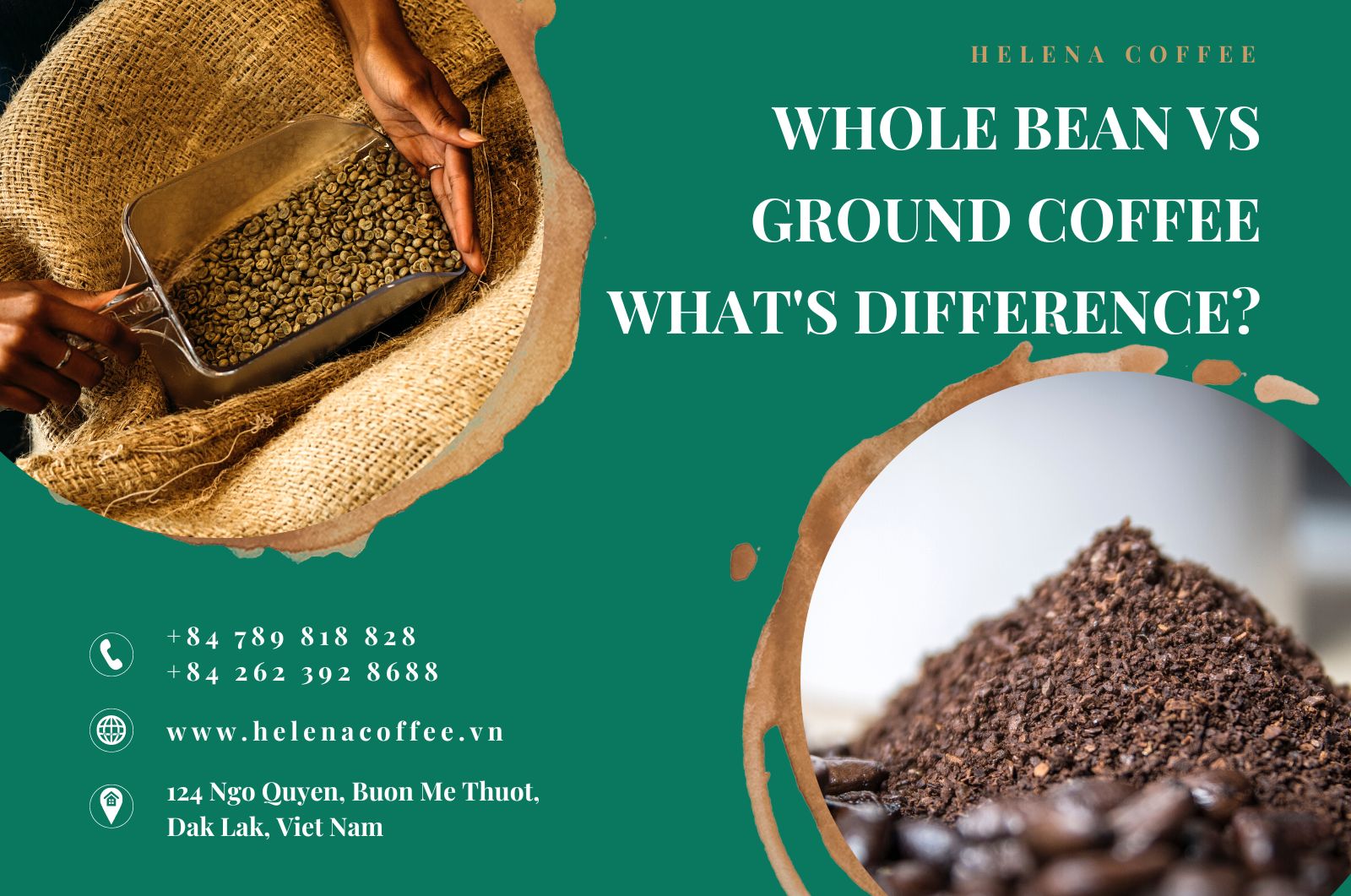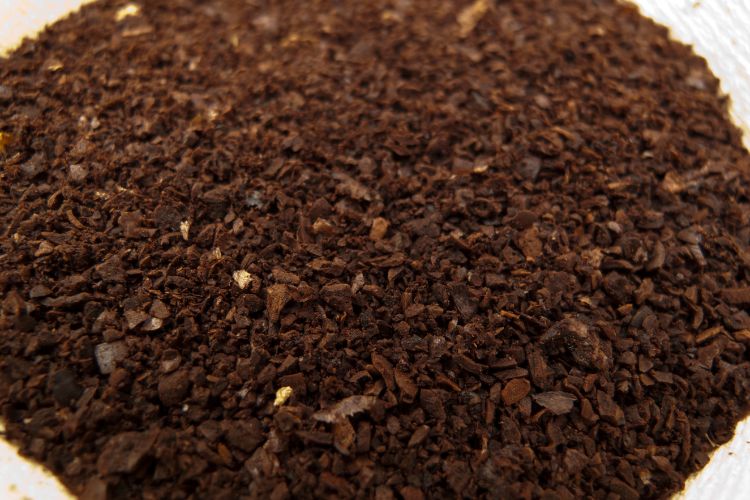
Whole Bean VS Ground Coffee: What’s Difference? Coffee lovers sometimes argue whether to use the whole bean vs ground coffee because each has advantages and disadvantages.
A cup of coffee is merely a cup for too many people who enjoy the beverage. They don’t stop to think about how the beans got to the cup since they know the end product is tasty.
Your coffee, however, contains more than meets the eye. No matter where your coffee comes from, it first goes through a harvesting, processing, and roasting procedure before being packaged and sold as whole beans or ground beans.
Choosing between whole and pre-ground beans is a crucial aspect of your coffee experience, regardless of whether you’re an expert or a casual coffee user.
Whole bean vs ground coffee
Whole bean coffee
Physical shape is the fundamental difference between ground and whole bean coffee.
Whole bean coffee is unground beans. If you buy a bag to brew at home, you’ll need a burr coffee grinder to grind the beans. Once they’re crushed, you may brew your coffee.

Local roasters sell whole bean coffee to preserve flavour and quality. This is why roasters transport whole bean coffee.
All coffee beans are roasted whole. Why buy whole beans if you have to ground them anyway? Whole beans hold a particular place in our hearts for several reasons (which we’ll get to later).
Ground coffee
Ground coffee is self-explanatory, like whole beans. This coffee has been ground after roasting, and before packaging, so the bag of roasted coffee beans you buy is ready to use.
Pre-ground coffee won’t have the same robusta flavours as fresh beans, but it has several benefits. Ask drip-brewer enthusiasts. Automatic dripper users often use pre-ground beans.
Grocery store items are usually the optimum grind size for a drip coffee machine, saving you time and energy. Blends and roasts are generally available.
Coffee comparison
Expiration
Before buying whole beans or pre-ground coffee, check the expiration date. Fresh coffee tastes the finest. Therefore, it’s crucial to store it properly. Both varieties of coffee must be stored differently.
Roasted coffee beans lose freshness over time. And the loss accelerates after grinding. Whole beans keep fresh the longest. They provide a more delicious, strong, and aromatic cup. Thus coffee lovers prefer them.

After being broken down, beans are more sensitive to humidity, heat, and elements. Coffee grinds deteriorate faster than entire beans. Bean coffee can lose its flavour and aroma if not stored properly.
Coffee should be stored in an airtight container away from light, heat, and moisture, preferably in a cold, dark cabinet. This keeps your coffee ready for any occasion. It’ll save money and a trip to the shop to replace mediocre coffee.
Flavour
Whole beans are freshest and most flavorful. Therefore coffee enthusiasts appreciate them. Most of the coffee’s delicate characteristics are kept because they aren’t treated after roasting. Roasters prefer to sell whole bean coffee to preserve the flavours and smells.
Ground coffee can be consumed despite being weaker than whole beans. If you don’t mind losing flavour, it can make fantastic coffee. Many coffee lovers prefer ground coffee since mixing flavours and creating roasts and blends is easy.
Flexibility
There is a difference in simplicity and accessibility between whole bean and ground coffee, whether you love a long morning of manual brewing at home or desire to make the brewing procedure as easy and quick as possible before work.
Beans are perfect for aspiring baristas who want to grind and brew at home. Whole bean coffee is a hands-on, manual technique that takes time and skill to perfect. Plus, you have to grind it yourself.
Pre-ground coffee saves time and energy, and purchasing and brewing are effortless. You don’t need to grind beans; scoop and brew.
Pulverization
Coffee grind size is significant whether you grind your beans or buy pre-ground bags. Grind size directly affects the coffee’s thickness and thinness. If you brew coffee at home, you’ll quickly learn the difference between coarse and fine grinds.
Grinding your coffee gives you greater freedom and control, allowing you to prepare drip coffee and espresso. If you want to grind your beans, we recommend a burr grinder (despite their cheaper pricing, avoid blade grinders!).

Pre-ground coffee is more straightforward for individuals without a burr grinder or less interested in freshly ground coffee since it saves a step. Pre-ground coffee is usually relatively uniform and consistent in grind size, even though you have less control.
Still, some pre-ground alternatives are more coarse or fine than others, so check the label before you purchase to get the right grind size for your brewing technique.
Whole bean vs ground coffee: Which’s the cheapest?
The cost of whole beans vs ground coffee is another consideration. Whole bean coffee is usually more costly because roasters must pay greater attention to the beans’ quality.

Mutated or low-quality beans are screened away before roasting. This ensures only healthy beans are roasted. Due to the extra effort necessary to filter the roast, the cost may be higher. Exotic coffee roasters supply entire beans with the most genuine and attractive taste.
Ground coffee is inexpensive since its ground without a strong emphasis on packing just the best beans. It’s also simpler for roasters to export ground coffee, so it’s more popular with consumers.
So…which coffee is best?
If you ask us, whole beans are better than ground coffee. Whole bean coffee offers the finest quality and most flavorful coffee. If you want to grind, measure, and brew coffee manually, try whole bean coffee.
Pre-ground coffee is best if you prioritize convenience. This is perhaps one of ground coffee’s best attributes since it’s become popular across socioeconomic classes.
If you’re interested in trying one or the other, buy a bag of beans or grinds and start experimenting.